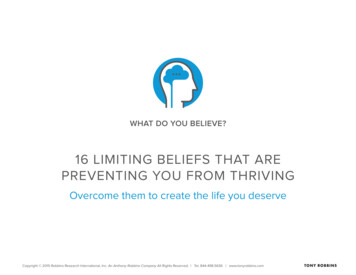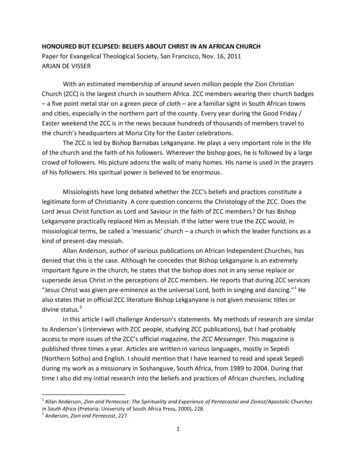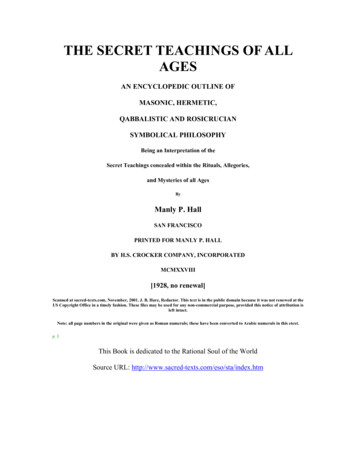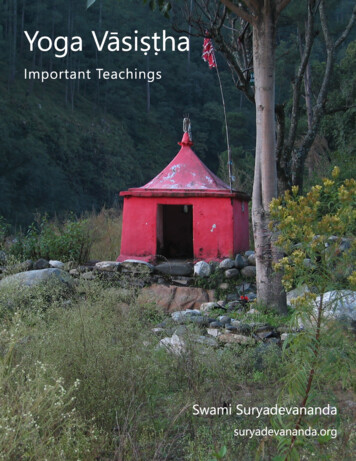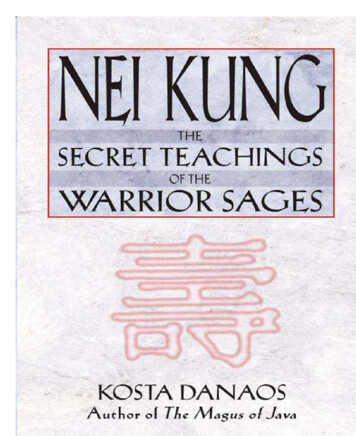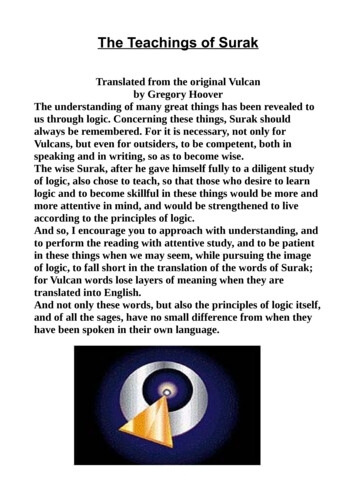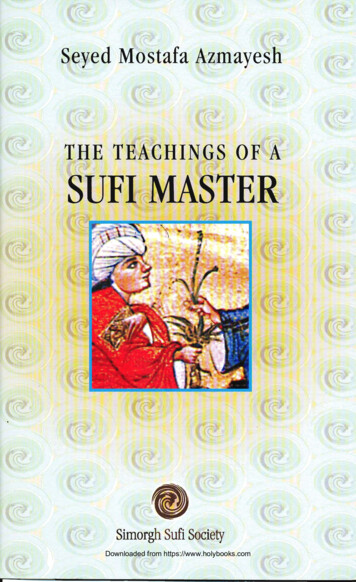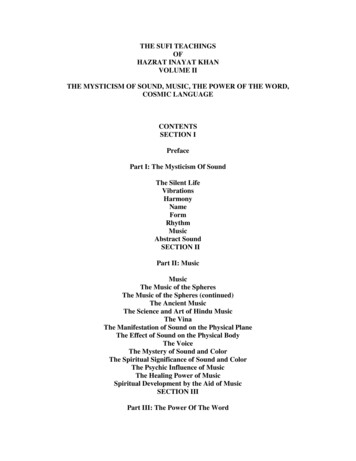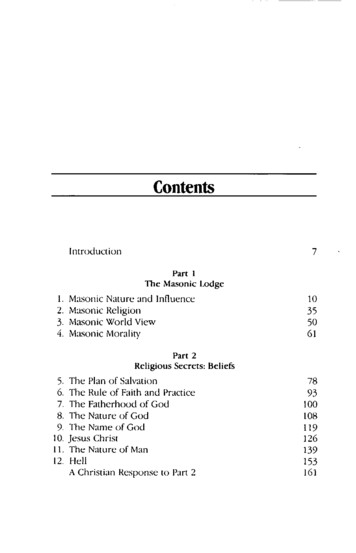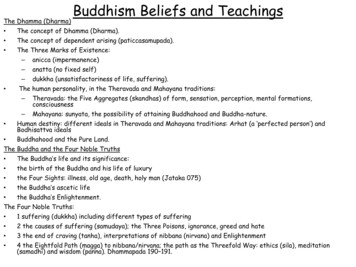
Transcription
The Dhamma (Dharma)Buddhism Beliefs and Teachings The concept of Dhamma (Dharma). The concept of dependent arising (paticcasamupada). The Three Marks of Existence: –anicca (impermanence)–anatta (no fixed self)–dukkha (unsatisfactoriness of life, suffering).The human personality, in the Theravada and Mahayana traditions:–Theravada: the Five Aggregates (skandhas) of form, sensation, perception, mental formations,consciousness–Mahayana: sunyata, the possibility of attaining Buddhahood and Buddha-nature. Human destiny: different ideals in Theravada and Mahayana traditions: Arhat (a ‘perfected person’) andBodhisattva ideals Buddhahood and the Pure Land.The Buddha and the Four Noble Truths The Buddha’s life and its significance: the birth of the Buddha and his life of luxury the Four Sights: illness, old age, death, holy man (Jataka 075) the Buddha’s ascetic life the Buddha’s Enlightenment.The Four Noble Truths: 1 suffering (dukkha) including different types of suffering 2 the causes of suffering (samudaya); the Three Poisons, ignorance, greed and hate 3 the end of craving (tanha), interpretations of nibbana (nirvana) and Enlightenment 4 the Eightfold Path (magga) to nibbana/nirvana; the path as the Threefold Way: ethics (sila), meditation(samadhi) and wisdom (panna). Dhammapada 190–191.
Teaching‘Thus, he realised the triviality of themundane life, which is bound to crumble,because if one is born one wouldundergo the process of ageing, sickness,death and all kinds of suffering Source of AuthoritySpecificationJataka 075Prescribed - 3.1.1.2 TheBuddha and the Four NobleTruths (page 11)Beliefs – The Dhamma, The Buddha and the four nobletruthsThe ascetic’s resolution to renouncethe worldly life in quest of the truthinfused greater happiness in his heartand inspired him to lead the life of anascetic.’‘He who has gone for refuge to theBuddha, the teaching and his Order,penetrates the transcendental wisdomof the Four Noble Truths – suffering,the cessation of suffering, and theNoble Eightfold Path leading to thecessation of suffering’“I take refuge in the Buddha. I takerefuge in the Dharma. I take refuge inthe Sangha.”Dhammapada 190 –191Declaration of faith, chant. Used inthe Sangha when they ‘take refuge’Prescribed - 3.1.1.2 TheBuddha and the Four NobleTruths (page 11)Beliefs – The Dhamma, The Buddha and the four nobletruthsBeliefs – The Dhamma, The Buddha and the four nobletruthsThe world is afflicted by death anddecay. But the wise do not grieve, havingrealized the nature of the world.The Buddha [Sutta Nipata]Beliefs – The Dhamma, The Buddha and the four nobletruthsIn Buddhism, ignorance as the rootcause of suffering refers to afundamental misperception of the truenature of the self and all phenomena.HH The 14th Dalai LamaBeliefs – The Dhamma, The Buddha and the four nobletruthsAttachment is the root of sufferingBuddhaPali CanonBeliefs – The Dhamma, The Buddha and the four nobletruths
TeachingAll conditioned things are impermanent. Allconditioned things are inherently lacking. Allrealities are devoid of an abiding selfSuffering I teach, and the way out of it’ – BuddhaSource of AuthoritySpecificationDhammapada 277-9Beliefs – The Dhamma, The Buddha and the four nobletruthsPali CanonBeliefs – The Dhamma, The Buddha and the four nobletruthsIf you walk the path, you will arrive at the end ofsuffering’ – BuddhaPali CanonBeliefs – The Dhamma, The Buddha and the four nobletruthsWe and all sentient beings fundamentally have theBuddha nature as our innermost essenceSogyal RinpocheBeliefs – The DhammaOne who sees paticcasamuppada sees theDhamma. One who sees the Dhamma sees paticcasamuppada’‘I am chief of the world, Eldest am I in the world,Foremost am I in the world. This is the last birth.There is now no more coming to be’ – Siddhartha’swords when born‘To Nirvana my mind has gone, I have arrived atthe extinction of evil desire’Majjhima Nikaya 1.190(Sutta Pitaka, Pali Canon)Beliefs – The DhammaJataka talesBeliefs –The Buddha and the four noble truthsBuddhaBeliefs – The Dhamma, The Buddha and the four nobletruthsAll beings love life and happiness. Takingyourself for comparison, you should neitherharm or kill, nor cause to harm or kill anotherbeingBuddhaBeliefs –The Buddha and the four noble truthsPractices – Buddhist ethicsThemes – Religion and life Themes – religion, humanrights and social justice Themes – religion, peace andconflict‘Some are reborn as humans; evildoers are reborn in hell.Doers of good are reborn in bliss and the pure enter Nibbana’Dhammapada 126Beliefs – The Dhamma, The Buddha and the four noble truthsPractices – Buddhist ethicsThemes – religion and life‘There is no need for temples, no need for complicatedphilosophies. My brain and my heart are my temples; myphilosophy is kindness’HH The 14th Dalai LamaBeliefs – The Dhamma, The Buddha and the four noble truthsPractices – Buddhist ethics‘Just seeing a portrait or statue of Buddha purifies our mindand plants the seed of enlightenmentKyabe Lama Zopa RinpocheBeliefs –The Buddha and thefour noble truthsPractices – Worship and festivals
TeachingSource of AuthoritySpecificationThe Buddha’s perfection is complete; thereis no more work to be done in him there isno cravingThere is no old age, sickness or death forme, my life is forever without end. I proceedburning bright like a flame‘Disciples of the Buddha are fully awakeboth day and night taking delight incultivating the heart’The truth of suffering is like adisease .and the truth of the path is likethe medicineHowever innumerable sentient beings are;I vow to save themDhammapada 179-180Beliefs – The Dhamma, The Buddha and the fournoble truthsNirvana SutraBeliefs – The Dhamma, The Buddha and the fournoble truthsDhammapada 301Beliefs – The Dhamma, The Buddha and the fournoble truthsPractices – Buddhist ethicsVisuddhimagga p512Beliefs – The Dhamma, The Buddha and the fournoble truthsPractices – Buddhist ethicsBodhisattva vowNot in the sky, not in the middle of the sea,not entering an opening in the mountains isthere that place on earth where standingone might be freed from evil actionNo one saves us but ourselves, No one canand no one may. We ourselves must walk thepath, but Buddha has clearly show the way.Dhammapada 127Beliefs – The Dhamma, The Buddha and the fournoble truthsPractices – Buddhist ethicsThemes – religion and life Themes – religion,human rights and social justice Themes – religion,peace and conflictBeliefs – The Dhamma, The Buddha and the fournoble truthsPractices – Buddhist ethicsBy action, knowledge and Dhamma, byvirtue and noble way of life – By theseare mortals purified, not by lineage orwealthDhammapada 165Majjhima Nikaya vol 3/262Beliefs – The Dhamma, The Buddha and the fournobletruthsThemes – religion, human rights and socialjustice Themes – religion, peace and conflictPractices – Buddhist ethicsBeliefs – The Dhamma, The Buddha and the fournoble truths
How to use this to make it stick!1.2.3.4.5.6.Read through the informationHighlight the key informationCreate a revision aid on it (flash card, mind map, acronym, cheat sheet etc)Test yourself on the revision aid (cover up and say it out loud cover upand write it out)Practice the past paper questions (without the revision aid)Review your answers with your revision aid (add anything you missed out)and rate your progressThe concept of Dhamma (Dharma) and The concept ofdependent arising (paticcasamupada)Dhamma: Universal law; ultimate truth; the teachings of Buddha. Spelt in Sanskrit as dharma.Paticcasamupada: The concept of dependent arising. The belief that everything in existence is becauseother things are. The idea that everything is interconnected and that everyone affects everyone elseConceptDescriptionSacred writing/ teachingWhy it is important for Buddhists/ how it influencesthemDhamma (Dharma) This is the teaching of the Buddha, itis the way the universe operates. It is the second of the three refuges(or jewels) So what the Buddha taught is, toBuddhists, a form of law. The Buddhist teachings include: Thethree marks of existence; the fourNoble Truths; the eightfold path etc. ‘My teaching is a means of practice, notsomething to hold on to or worship. Myteaching is like a raft used to cross theriver.’ Following the teachings has relieved manyBuddhists from suffering, giving them meaning andpurpose and greater happiness in life. Becoming more aware, wise and compassionate isgood for them. It transforms their relationships with others andthe wider world.Dependent arising (paticcasamupada) The Buddhist vision says thateverything arises and continues,dependent on conditions. Nothing ispermanent and unchanging. Life is an interdependent weatherconditions. For example, a tree dependson soil, rain and sunshine to survive.Nothing is independent of Supportingconditions, this means nothing iseternal - including humans. Everythingis in a constant process of change The Tibetan wheel of lifedemonstrates the process ofdependent arising in relation to thehuman life, death and rebirth cycle.Many Buddhist believe that when theydie, the consciousness transfers toanybody. The wheel shows the continuallife of birth, death, and then rebirth.This cycle is called Samsara. All events and incidents in life are sointimately linked with the Fate of othersthat a single person on his or her owncannot even begin to act. – Dalai Lama The ultimate aim is to Break Free of the cycle ofSamsara, because this causes suffering. The cycleis broken by following the Buddhist path and threebreaking the habit of craving (tanha).Test yourself1. Which one of the following means living a simple life? (1 mark)Sunyata B) Ascetic C) Enlightenment D) Meditation2. Give two of the four sights that the Buddha saw (2 marks)3. Explain two ways in which belief in the Buddha’s enlightenment influences Buddhists today (4 marks)4. Explain two Buddhist beliefs about the Buddha's ascetic life. Refer to scripture/sacred writings inyour answer (5 marks)5. ‘The stories of the Buddha’s birth have no relevance for Buddhists today.’Evaluate this statement (12 marks)Based on my revisions and testing I need to focus on:
The three marks of existence: dukkha,anicca, anattaThree marks of existence:Dukkha: the first noble truth – there is sufferingAnicca: impermanence – everything is changingAnnata: the idea that people do not have a permanent, fixed self or soulAniccaAnattaDukkhaWhat is it? All things are impermanent, everything changes. All things We have no permanent self becausethat exist did not exist at one time and everything willwe are always changing. We have noeventually cease to exist.soul. During their existence, things are constantly changing. This They just argue that your identity isis because everything is interdependent, everythingan illusion. Body is made up of thingsinteracts with everything else and so affects change inthat it takes into itself: the air thatother things.surrounds you, what you eat, etc.Those things become you. Youridentity merges with yourenvironment and cannot beseparated from it. You have noseparate self.Quote/ teachingThe story of the mustard seed – ‘The Buddha reminded Kisathat plants grow in the spring, flower in the summer, and die inthe winter - and that new plants grow the following year.Similarly, people are born and eventually die. Kisa nowunderstood that was just how things are.’If all the harm, fear, and suffering inthe world occur due to grasping ontothe self, what use is the great demonto me?‘What I teach is suffering and the cessation ofsuffering.’ – The BuddhaWhy is itimportant?By understanding that everything changes we will not becomeattached to things. This will hopefully reduce craving andsuffering.By understanding anatta we will craveless as we have no one to crave for.It is important to accept suffering so we cando something about it. (see 4 noble truths) Suffering and the unsatisfactory nature oflife It is dissatisfaction and suffering. Buddhisttried to reduce suffering for themselvesand others through right actions andintentions, and by gradually increasing theirunderstanding of reality. Eventually theyhope to break out of the cycle of Samsaraand achieve Nirvana. There are three types of dukkha. 1) dukkha-dukkhata: this refers to pain orsuffering it is used to describe bothphysical and mental pain. 2) viparinama-dukkha: The process ofChange - when something changes and asense of happiness is lost as a result. 3) samkhara-dukkha: Link to the idea ofattachment. When people crave and try tohold on to things they are attached to, theysuffer.
Theravada Buddhism & The Five Aggregates(skandhas) of form, sensation, perception,mental formations, consciousnessTheravada Buddhism: The school of the Elders; ancient Buddhist tradition foundin Southern Asia.The five aggregrates: the five aspects that make up a personTheravada Buddhism grew from the original Sthavira school and so thinks ofitself as being closest to the Buddhism of Siddattha Gotama.At the heart of Theravada lie Three Universal Truths and the Four NobleTruths. For Theravadins they imply that all life is liable to suffering, and thatthe Buddhist path is the way to escape from this life and, perhaps after manylifetimes of practicee, to achieve NibbanaThey believe in the Five aggregates (Skandhas) that make up a human identityand personality:1. Form, 2. Sensation, 3. Perception, 4. Mental Formations, 5.Consciousnessfollow strict rulesThe fiveaggregrates1. FormWhat is it?Why is itimportant?Mahayana: sunyata, the possibility of attainingBuddhahood and Buddha-natureMahayana Buddhism: An umbrella term to describe some Late of Buddhist traditions. Including pureLand Buddhism, Tibetan Buddhism, Zen BuddhismSunyata: Emptiness; the concept that nothing has a separate, independent self or soulBuddha nature: The idea that everyone has the essence of the Buddha inside them.Buddhahood: When someone achieves enlightenment and becomes a Buddha.Mahayana developed from the progressive Mahasanghika group, though today it’s not a single group, buta name that can be applied to a large number of Buddhist sects. Mahayana means great vehicle. Theydon’t disagree with the Theravada ideas as they also follow the Four Noble Truths and the Eightfoldpath but believe Theravada tradition and beliefs is limited. a more progressive movementThey believe all people have equal access to Buddahood and enlightenment. Everyone has a BuddhaNature. To achieve this you have to understand the concept of sunyata (emptiness) Nothing existsindependently.Sunyatahis translates as emptiness for Mahayana Buddhists understanding sunyata is important for achievingenlightenment.It emphasises that human beings do not have a fixed, independent, unchanging nature. Nothing existsindependently but only in relation to other things.This refers to material or physical objects. TheravadaMade up of the elements air, earth, fire and Buddhists believewater. For example, a house, an apple, allthat these fivethe organs that make a person.parts of humanpersonalityThis refers to the feelings or sensationsinteract with eachthat occur when someone comes intoother to make up acontact with things. They can be physicalperson's identity(such as a sensation of pain) oremotional(such as a feeling of joy)How it influences Buddhists:The Buddhist realising that everything depends on, and interlinked with, everything else can lead totrust, compassion and selflessness.3. PerceptionThis refers to how people recognise whatthings are, based on previous experiences.For example you might recognise what thefeeling of happiness means because youhave felt it before.Buddha-nature and BuddhahoodMahayana Buddhists believe that everyone has Buddha nature- that is they have the potential tobecome Buddha, to become enlightened. It is the practice of Buddhism that helps us to realise ourBuddha nature for ourselves.4. MentalFormationsThis refers to a person's thoughts andopinions - how they respond mentally tothings they experience, including their likesand dislikes, and the attitudes towardsdifferent things.Sometimes it is argued that deep down every person is already enlightened. But a person's Buddhanature is hidden by desires, attachment, ignorance and negative thoughts.This refers to a person's general awarenessof the world around themMahayana Buddhists aim to achieve buddhahood: To become a Buddha (an enlightened being). Theybelieve everyone has the potential to do this.2. Sensation5.ConsciousnessWhy it is important:Realising that everything is impermanent is important for reducing the suffering that results inbecoming too attached to things.These realisations are important for achieving enlightenment.It is only when people understand the nature of themselves and the reality around them, byunderstanding Buddhist teachings. That they experience the Buddha nature that was always there.
Human destiny: different ideals in Theravada andMahayana traditions: Arhat (a ‘perfected person’)and Bodhisattva idealsWhat is it?ArhatFound in Theravada Buddhism,it means perfect being, onewho is gained insight into thetrue Nature of existence andhas achieved Nirvana.They have overcome the maincauses of suffering - the threepoisons. When someonebecomes an Arhat, they are nolonger reborn when they die.This means they are finallyfreed from the suffering ofexistence in the cycle of birthand death. This goal isachieved by following theeightfold path andconcentrating on wisdom,morality and meditation.Bodhisattva Found in Mahayana buddhism,this means ones whose essenceis Bodhi (enlightened). Theybelieve the bodhisattva hasmade a veil to postpone the fullenlightenment in order to helpother beings.They see this as a higher beingthan the arhat.They can transfer their ownmerit to their followers,therefore helping them.The stages of being abodhisattva are:1) declaring the intention toput of buddhahood to helpothers.2) taking vows to showdetermination.3) working hard to develop andperfect the six perfections.4) becoming enlightened andattaining buddhahood.Quote/TeachingWhy is it important?I have no teacher, and It is the idealone like me existachievement fornowhere in the world.Theravada BuddhistsI am the TeacherSupreme. I alone am aFully Enlightened One.Whose fires arequenched andextinguished. – TheBuddhaHowever innumerablesentient beings are; Ivow to save them - ABodhisattva vowMahayana Buddhistsbelieve there areearthly andtranscendentbodhisattvas. TheAshley ones continueto be reborn in theworld, to live onEarth, while thetranscendent onesremain in someregion between theEarth and nirvana, asspiritual beings.However, theyremain active in theworld, by appearingin different forms tohelp others and leadthem toenlightenment.Pure Land BuddhismIs part of the Mahayana tradition. It began in China as early as the second centurybut is mainly practiced in Japan today.Pureland is based on faith in Amitabha Buddha in the hope of being reborn in thearadise where Amithaba lives. Amithaba was a king that renounced his throne tobecome a monk. Mahayana scriptures tell how when he achieved enlightenment andbecame a Buddha, he created his own pure land called Sukhavati where there is nosuffering. Believe enlightenment can be achieved with help from Amitabha rather thanthrough ones thoughts and actions.Practiced in: Japan
The Buddha’s life and its significanceStageThe birth ofthe Buddhaand his lifeof luxuryDescriptionImportance/ How it influences Buddhists‘I had three mansions; onefor the winter, one for thesummer, and one for therainy seasons’ – TheBuddha Born into a rich, noble clan in Lumbini in northern India. His father was a nobleman and mother aqueen (Maya)His mother had a vision of 6 tusked elephant entering her from highest heaven. Brahmins (priests)said this was an omen and that she would give birth to a child who would achieve perfect wisdom.She gave birth to Siddattha under a bodhi tree. He shot out of her side and took seven steps in allfour directions, lotus flowers blossoming in his footsteps. He declared that this was his last life andhis last body and that he would defeat the sorrow caused by birth and death.A seer predicted that he would either become a great ruler or a religious leader. His father wantedhim to following his footsteps so tried to keep him from suffering.Became a very gifted and brave young man, was married at 16 and had a son. Siddhatta become curious and left the palace with his charioteer Channa · He saw 4 sights. 1) Dead man 2) Old man 3) Sick man (These taught him that we all suffer (dukkha)and that life is impermanent as we will all die (anicca) and we all grow old and change (anatta) 4) Holyman - This inspired him to pursue a more spiritual path to find an end to suffering The FourSightsTeaching The Buddha’sascetic life The Buddha’sEnlightenment AfterEnlightenment Siddhattha decided to leave the palace for good and embarked upon the life of a wanderer, sleepingin forests and living off the food given to him by those he came into contact with.Siddhattha decided that enlightenment could be won by pushing the body to extremes so he becamean ascetic.This meant that he took on rigorous fasting (eating one grain of rice a day!)Thus he became extremely ill and was no nearer to enlightenment and when a young cow-girl offeredhim some rice milk he took it and realised that life as an ascetic was not going to lead him to nibbanaHe realised that enlightenment had to be found by living ‘the middle way’ between the extremes ofhardship and luxury.‘When the Great Being waspractising severeausterities for six years itwas to him like a time ofintertwining the sky withknots. Releasing that thepractice of suchausterities was not thepath to Enlightenment hewent about gathering almsin villages’ Six years after Siddhattha had left his home and family he sat under a Bodhi-tree at Bodh Gaya,determined to gain enlightenment once and for all.First he entered into a series of trance-like states known as jhanas. And then, going beyond these, hegained insight into the true nature of reality.During his enlightenment experience, Siddhattha attained three types of knowledge. (i) First he sawthat he had died and been reborn many times: (ii) Then, having acquired the 'divine eye', he saw thatall beings are reborn according to their deeds, the law of kamma. (iii) He saw the nature ofsuffering, the origin of suffering, the cessation of suffering and the way leading to the cessation ofsuffering - in short, the Four Noble Truths.During the course of the evening he was tempted by Mara (a sort of devil) and his daughters whotried to seduce him and offer him food and physical luxuries.‘Let only my sin, sinews andbone remain and let theflesh and blood in my bodydry up; but not until Iattain the supremeEnlightenment will I giveup this seat of meditation.’ The first thing Siddattha did was speak to the five ascetics (his former companions) in the DeerPark in Benares. This is referred to as 'Setting into Motion the Wheel of Dhamma'.In his first sermon, the Buddha advises against the two extremes of luxury and hardship and offersa 'Middle Way'. He taught about the Eightfold PathForming of the sangha: Originally the Buddha and his monks (bhikkhus) travelled around, meetingtogether during the rainy season.Lay Buddhists continued to live a ‘normal’ life. The lay community (lay Sangha) supported thebhikkhus (monastic Sangha) by providing them with food and clothing, and accommodation during therainy season.These buildings gradually became permanent monasteries (called viharas, literally ‘resting places’) wherethe monks lived all year. · He taught for the next 45 years to all of his followers – both Bhikkhus andlay BuddhistsEven before his conception, Siddhartha Gotamawas special.Prophecies were made saying Gotama wouldbecome a holy man and renounce his life ofextreme wealth and luxury – these became true.His statements at birth show that we are drivenby past livesThe encounter with death shows theimpermanence of the material world – no amountof money can stop thisSeeing the Four Sights with no comprehension ofthem beforehand was mind-blowing – it resulted inSiddhartha renouncing his life of extreme wealth,rejecting it as not satisfactory.The holy man gave him a potential solution to thedissatisfaction caused by the other three – areligious pathMeditation is an important theme throughout thelives of BuddhistsIt may take many lives to reach enlightenment –we learn in each one Even with great determination a person can bedistracted and have doubts. Enlightenment comes from the power of the humanmind, not a divine intervention. Siddhattha’s realisations form the basis ofBuddhist teachings The lotus flower is a symbol for BuddhismThe Buddha taught everyone how to reachenlightenment – this shows Buddhism is foreveryone, regardless of gender, age or creed –shows compassion and concern for all.
The four noble truths, Eightfold path, Arhatand BodhisattvaThe Four Noble Truths1). All life involves suffering (dukkha) This is the problem that needs to be overcome. This is important because you need to understand the problem if we are to dosomething about it.2). The cause of suffering (dukkha) is craving (Samudaya) Craving causes suffering because we feel upset/disappointed when the things wecrave change. We crave things because our actions are motivated by greed, hatred and desire(the three poisons). This is important because once you know the cause of the problem you can tryto stop it.3). The way to end Dukkha is nirodha We need to overcome samudaya in order to stop dukkha. This can be done by finding happiness inside ourselves rather than craving forthings. This is important as it tells us how to overcome the problem.SectionWay ofMoralitySilaRight ActionSamadhiWhat is it?Why is it important?Not acting in a way to harm others Generates good kammaor yourself. This includes all of Helps to follow the 5the 5 precepts.preceptsRight Speech You should not speak in ways tohurt others e.g.: lies, gossip, idlechatter, swearing. Generates good kamma Helps to follow the 5preceptsRightLivelihood Generates good kammaWay of RightmentalEfforttraining/Meditation4). The way to overcome samudaya is the Middle Way Magga A life of luxury will cause you to form too may attachments and crave but a lifeof hardship will cause one to crave the bare necessities. Buddhists believe that you should live the middle way between the two. By following the 8 fold path you can live the middle way This is important as it gives strategies to overcoming craving and thereforesuffering.Test yourself1. Which one of the following means living a simple life? (1 mark)Sunyata B) Ascetic C) Enlightenment D) Meditation2. Give two of the four sights that the Buddha saw (2 marks)3. Explain two ways in which belief in the Buddha’s enlightenment influences Buddhiststoday (4 marks)4. Explain two Buddhist beliefs about the Buddha's ascetic life. Refer toscripture/sacred writings in your answer (5 marks)5. ‘The stories of the Buddha’s birth have no relevance for Buddhists today.’Evaluate this statement (12 marks)Based on my revisions and testing I need to focus on:8 Fold PathRightMindfulnessBuddhists should only get a jobwhich does not harm others butbenefits others. E.g. a butcher orsoldier would be against rightlivelihood.Buddhists should make an effort Enables Buddhists toto put aside negative thoughts and complete other aspects ofreplace them with positive ones.the path.With out effort the other parts With out effort meditationof the path can not be achieved.would be impossibleThis is being mindful or aware ofyourself and everything aroundyou. You can not be in control ofyour life if you are not aware ofthese things. By being mindful this willenable a Buddhist tounderstand how theiractions effect others.RightRight concentration is needed for This is vital for meditationwhich will hopefully lead toConcentration meditation. Through meditationthe mind can become clam and gain enlightenment.insight, hopefully leading toenlightenment.Way ofWisdomPrajnaRightViewUnderstanding life as it really is.Therefore understanding thedhamma (the Buddha's teachings)RightIntentionThis is the motivation behind your Right intention underpinsactions. Actions should bethe rest of the path.motivated by unselfish love for all With out the right intentionbeings.no kamma will be generated. By having right view you willunderstand the dhammaenabling you to increaseyour chances ofenlightenment.Test yourself:1 . Which one of the following means a Buddhist teacher?A) Sunyata B) Asceticism C)Thereavada D) Bodhisattva2.Give two of the eightfold path (2Marks)3. Explain two ways in which belief in the Four Noble Truths influences Buddhists today. (4 marks)4. Give details of two Buddhist beliefs about the third noble truth refer to scripture or sacred writings in your answer(5Marks)5. Bodhisattvas should not have a god-like status because that is not what Buddhism is all about (12Marks)Based on my revisions and testing I need to focus on:
Theravada Buddhism, Mahayana Buddhism and Pure Land BuddhismTheravadaWhat it issimilaritiesDifferencesTheravada Buddhism grew from the original Sthavira schooland so thinks of itself as being closest to the Buddhism ofSiddattha Gotama.Siddhartha Gautamawas a Buddha andTeacherThree Marks ofExistence4 Noble TruthsEnlightenment At the heart of Theravada lie Three Universal Truths and theFour Noble Truths. For Theravadins they imply that all life isliable to suffering, and that the Buddhist path is the way toescape from this life and, perhaps after many lifetimes ofpracticee, to achieve NibbanaThey believe in the Five aggregates (Skandhas) that make upa human identity and personality:1. Form, 2. Sensation, 3.Perception, 4. Mental Formations, 5. Consciousnessfollow strict rulesMahayanaMahayana developed from the progressive Mahasanghikagroup, though today it’s not a single group, but a name thatcan be applied to a large
virtue and noble way of life – By these are mortals purified, not by lineage or wealth . Majjhima Nikaya vol 3 /262 . Themes – religion, human rights and social justice Themes – religion, peace and conflict . Practices – Buddhi

